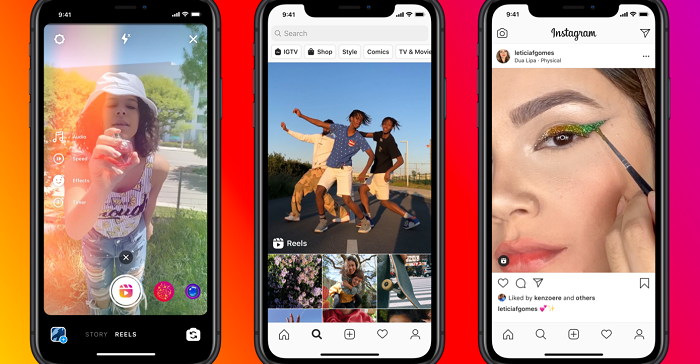SOCIAL
Instagram Faces More User Backlash as it Continues to Chase TikTok

I don’t know about you, but I’m finding Instagram’s home feed, which is now littered with recommended posts from accounts that I don’t follow, less and less compelling these days.
As has been well documented, Instagram has been chasing the TikTok dragon, by trying to re-align its home feed around recommended content from across the app, which then gives it a far broader pool of compelling posts to highlight in each users’ feed. TikTok has seen great success with this approach, which expands the pool of content that it can choose from beyond each users’ immediate connections, with the top-performing content approach then facilitating a more compelling, engaging ‘For You’ feed experience.
Except, it hasn’t really worked that way on IG, with its shift to more recommendations sparking significant user backlash, which has since forced Instagram to scale back its approach.
And just last week, Instagram CEO Adam Mosseri also admitted that it’s now also gone too far in pushing video in the app, which has turned even more users away.
So why hasn’t it worked – what does TikTok do better than Instagram in this respect, which makes its app compelling, while repelling IG users?
Part of it is expectation, and Instagram looking to shift away from what it once was. Instagram users have come to expect a certain experience in the app, and that makes it harder for IG to pull away from it – and thus far, the platform has been moving too quickly in its various pivots, which has annoyed users.
Instagram can still do this, it just needs to move more slowly. Which is what it’s now looking to do, with Meta CEO Mark Zuckerberg still expecting to see AI recommendations double in the app over the next year. That’ll likely still annoy many Insta users, but if Instagram shifts to a more gradual integration, ramping up its recommendations and video pushes over time, it could still work, and enable IG to merge into TikTok’s territory.
It’s just that TikTok is still growing, really fast, and you can imagine that Mosseri and Co. will be feeling the pressure to keep up where they can, which is being hampered by user backlash.
But there is another element that’s often overlooked in TikTok’s rise – though many studies and research reports have clearly highlighted this as a significant concern.
TikTok, for better or worse, utilizes base human desires as a growth engine in the app. In other words, TikTok highlights a lot of half-dressed young men and women, as a means to maximize engagement, which Instagram doesn’t, at least not in the same way.
In my personal experience, TikTok has repeatedly pushed videos of bikini-clad young girls into my feed, despite my direct indications that I am not interested in this content. Of course, I’m well aware that this is algorithm based, and that the app will only show you more or less of what you engage with. But in this case, I have deliberately indicated to the app, in every instance, that I’m not interested in such, via the available prompts, as a means to test whether they keep coming up regardless. And they do – TikTok knows that this type of content will keep people coming back, despite the fact that it’s exposing these users in ways that are not entirely healthy.
That’s been the core criticism from many child health and safety advocates, who believe that TikTok promotes sexualized content at the expense of young users, many of whom are left with mental health issues as a result.
According to the American Psychological Association, the sexualization of girls directly correlates with difficulties in developing a ‘healthy sexual self-image’:
“Research links sexualization with three of the most common mental health problems diagnosed in girls and women – eating disorders, low self-esteem, and depression or depressed mood.”
TikTok feeds into such behaviors by pushing this type of content into user feeds, even if, as noted, they haven’t expressed an interest in such. My personal experience is anecdotal, but various other studies have found the same:
“Trends on TikTok are especially prone to this, and many young girls have taken to participating in trends that require a hypersexualisation of themselves, their attitudes and personalities, and their bodies. One might argue that some of these trends promote “body confidence”, however, the nature of these challenges involves the components of sexualisation that the American Psychological Association outlines.”
Where TikTok may be particularly harmful in this respect is in its advanced AI and entity identification, which enables it to show people more videos that they might like based on very specific traits.
Back in 2020, a leaked internal document showed that TikTok moderators had been instructed to suppress content that featured people who were ‘too ugly, poor, or disabled for the platform’. TikTok has said that such regulations were quickly removed from its guidance, but the very concept that TikTok is even able to do this, based partly on algorithm identification, suggests that its systems are able to use such parameters as ranking tools – which means that TikTok can, and likely does, use physical traits like this to show people more of what the like, and less of what they don’t.
In other words, TikTok’s AI can detect physical elements, and use them as matching parameters, in order to keep users scrolling. Extrapolate that to different body types, exposed skin, hair, eyes, etc.
That then opens up a whole other area of concern.
As explained by BuzzFeed:
“One of the most popular kinds of videos from TikTok’s users, who are mostly young and female, are lip-synch videos, where they dance and sing along with their favorite songs. These performances are sometimes sexualized by older men who lurk on the app, sending the young creators explicit messages and, in some cases, remixing the videos and dancing along with them via a TikTok feature called “duet.” And the platform doesn’t just overlook this kind of conduct, its core mechanics inadvertently facilitate it. It learns what you like and shows you more and more of it. It also reacts in real time, delivering an endless stream of similar videos, even if you aren’t logged in.”
In other words, if creepy lurkers keep liking videos of youngsters dancing, they’re going to keep coming up on his or her ‘For You’ page, while they’ll also be more specifically highlighted based on physical traits and types.
Instagram doesn’t match content in the same way, and while there are also issues with over-sexualization on IG as well, TikTok weaponizes this, in ways that Meta likely wouldn’t even risk, in fear of being taken to task in the media.
But TikTok gets away with it because of its personalized algorithms, because many users are afraid to point this out, for fear of exposing their own usage behaviors. But it seems like more than that – TikTok uses this as a key growth strategy, again utilizing carnal desires to lure people in, and keep them scrolling through the app.
In this sense, TikTok is not as harmless as viral dance trends might make it seem – though this also means that it’ll likely remain ahead of Instagram in this respect, at least for the time being.
Until IG takes a similar approach, and pushes more of this type of content into more user feeds, or TikTok gets pulled up on such as it allows more access into its algorithms.
Though I suspect that TikTok will resist opening up its black box of entity identification for this reason, which will enable it to keep on rising, while fueling more concerning trends.
That puts IG in an increasingly difficult position – but you can bet that Meta’s growing army of lobbyists in Washington will be pushing this angle at every opportunity.



















You must be logged in to post a comment Login